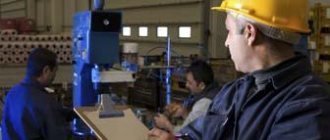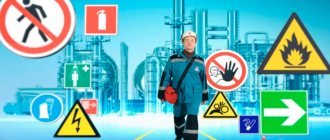The employer's policy in the field of labor protection is a public declaration of the employer's intentions to fulfill obligations to ensure state regulatory requirements for labor protection (see Order of the Ministry of Labor 438n dated August 16, 2016).
Employer's labor protection policy sample
In the occupational safety and health policy, the organization specifies its occupational safety and health goals and what obligations it undertakes to achieve these goals.
For example, the declared goal is to prevent occupational diseases. To do this, the employer undertakes to consult with employees on labor protection, conduct risk assessments in the workplace, train employees, etc. Well, to achieve these goals, along with the occupational safety policy, another document is being developed: the “Occupational Safety and Health Action Plan,” which clearly states what will be done and when.
The employer's policy in the field of labor protection is an integral part of the labor protection management system (OSMS), which the employer of any organization in Russia is obliged to provide in accordance with Art. 212 Labor Code of the Russian Federation.
The policy must be issued in the form of a separate local document of the organization, or be one of the sections of the OSMS.
The occupational safety policy must be available to all employees of the enterprise! Therefore, it is advisable to prepare it on 1-2 pages and post it on the organization’s website, at a stand or occupational safety corner.
Normative documents for policy development
— Order of the Ministry of Labor of the Russian Federation No. 438n dated August 19, 2016 “On approval of the Standard Regulations on the Occupational Safety and Health Management System.”
— GOST 12.0.230-2007 System of occupational safety standards (SSBT). OT management system. General requirements.
— GOST R 12.0.007-2009 System of occupational safety standards (SSBT). OSH management system in the organization. General requirements for development, application, evaluation and improvement.
— Article 210 of the Labor Code of the Russian Federation “Main directions of state policy in the field of labor protection.”
New Model Regulations on the Labor Safety Management System!
Pages:SelectHome Feed Chat Author Services Training SOUTH Search Headings:Select OCCUPATIONAL HEALTH FIRE SAFETY INDUSTRIAL SAFETY ELECTRICAL SAFETY ENVIRONMENTAL SAFETY Civil Defense and Emergencies OCCUPATIONAL HEALTH QUESTION/ANSWER Educational program LABOR CODE VIDEO RUBRIC DOWNLOAD FILE NEW OSTI NPA 10/18/2016 Greetings, dear friends!
Urgent news for those who work in the field of labor protection! Yesterday, October 17, the Order of the Ministry of Labor and Social Protection of the Russian Federation dated August 19, 2016 was published on the official Internet portal of legal information No. 0001201610170013.
No. 438N
“On approval of the Standard Regulations on the Occupational Safety and Health Management System”
.
Order No. 438N was registered with the Ministry of Justice of Russia on October 13, 2016 under number 44037. The document comes into force on October 28, 2016.
As is known, in accordance with the Labor Code of the Russian Federation, the employer is obliged to ensure the creation and operation of an occupational safety and health management system (hereinafter referred to as the OSH). The purpose of the standard provision is to assist employers in creating an OSMS and its operation. The standard regulation establishes the recommended structure and approximate content of the OSH regulations for a specific employer.
The structure of the occupational safety and health system for employers with fewer than 15 employees can be simplified, subject to compliance with state regulatory labor protection requirements. The basis for the organization and functioning of the OSMS is the provision on the OSMS, approved by order of the employer, taking into account the opinion of employees (representative body). This provision must define the employer's policy and goals in the field of labor protection; ensuring the functioning of the OSMS (distribution of duties and responsibilities in the field of labor protection between the employer’s officials); procedures aimed at achieving the employer’s goals in the field of labor protection.
Provision is made for planning procedures; control of the functioning of the OSMS and monitoring of the implementation of procedures; planning improvements to the functioning of the OSMS. Issues of responding to incidents, emergencies, industrial accidents and occupational diseases are considered.
The standard provision includes the following sections:
- planning improvements in the functioning of the OSMS;
- procedures aimed at achieving the employer’s goals in the field of labor protection;
- features of the creation and functioning of an OSMS in individual organizations.
- employer's goals in the field of labor protection;
- responding to incidents, emergencies, industrial accidents and occupational diseases;
- ensuring the functioning of the OSMS (distribution of duties and responsibilities in the field of labor protection between the employer’s officials);
- procedure planning;
- control of the functioning of the OSMS and monitoring of the implementation of procedures;
- employer's policy in the field of labor protection;
The only thing left to do is to develop your own based on the standard provision That’s all. Don't forget to put stars and leave
Stages of policy development in the field of occupational safety and health
Conventionally, the creation of a labor protection policy can be divided into several stages:
1) Preliminary analysis of the state of labor protection in the organization
The analysis includes checking the compliance of labor protection issues with legal requirements and assessing the hazards that may arise during the work process at each of these stages.
In practice, to conduct a preliminary analysis, the employer and occupational safety officer hold a meeting of workers to discuss which occupational safety issues will be included in the policy. Based on the results of the meeting, a protocol must be drawn up.
The results obtained will be the starting point against which future policy outcomes will be compared.
2) Direct concept of labor protection
Based on the results of the analysis, policies are developed aimed at improving and improving the current state of labor protection. It is its provisions that determine the further vector of development of the organization in this direction.
3) Goals
The final result of the implementation of the policy in the field of labor protection is the setting of certain goals and deadlines for achieving these goals.
4) Achieving goals
The policy must detail the mechanism for achieving the intended goals, as well as correctly distribute duties and responsibilities “on the path to the goal.”
An assessment of the effectiveness of policy implementation will be a comparative analysis with that very “starting point”, that is, the primary analysis of the state of labor protection.
List of changes (list of new rules in 2021)
Occupational Safety and Health
- Rules for labor protection when working at height, approved by Order of the Ministry of Labor of Russia dated November 16, 2020 No. 782n. We have an article where all the changes compared to the rules in force previously are discussed in detail.
- Rules for labor protection in sea and river ports, approved by order of the Ministry of Labor of Russia dated June 15, 2020 No. 343n.
- Rules on labor protection in logging, woodworking industries and when performing forestry work, approved by Order of the Ministry of Labor of Russia dated September 23, 2020 No. 644n.
- Rules for labor protection during the operation of railway infrastructure facilities, approved by Order of the Ministry of Labor of Russia dated September 25, 2020 No. 652n.
- The rules for labor protection when carrying out work in the metro, approved by order of the Ministry of Labor of Russia dated October 13, 2020 No. 721n, come into force on September 1, 2021.
- Rules for labor protection in agriculture, approved by order of the Ministry of Labor of Russia dated October 27, 2020 No. 746n.
- Rules for labor protection during loading and unloading operations and placement of cargo, approved by Order of the Ministry of Labor of Russia dated October 28, 2020 No. 753n.
- Rules for labor protection in housing and communal services, approved by order of the Ministry of Labor of Russia dated October 29, 2020 No. 758n.
- Rules for labor protection when applying metal coatings, approved by Order of the Ministry of Labor of Russia dated November 12, 2020 No. 776n.
- Rules for labor protection when carrying out work in light industry, approved by Order of the Ministry of Labor of Russia dated November 16, 2020 No. 780n.
- Rules for labor protection in cement production, approved by Order of the Ministry of Labor of Russia dated November 16, 2020 No. 781n.
- Rules for labor protection during the operation of industrial vehicles, approved by Order of the Ministry of Labor of Russia dated November 18, 2020 No. 814n.
- Rules for labor protection in the implementation of security (protection) of objects and (or) property, approved by Order of the Ministry of Labor of Russia dated November 19, 2020 No. 815n.
- Rules for labor protection during printing work, approved by Order of the Ministry of Labor of Russia dated November 27, 2020 No. 832n.
- Rules for labor protection during placement, installation, maintenance and repair of technological equipment, approved by Order of the Ministry of Labor of Russia dated November 27, 2020 No. 833n.
- Rules for labor protection when using certain types of chemicals and materials, during dry cleaning, washing, disinfection and decontamination, approved by Order of the Ministry of Labor of Russia dated November 27, 2020 No. 834n.
- Rules for labor protection when working with tools and devices, approved by Order of the Ministry of Labor of Russia dated November 27, 2020 No. 835n.
- Rules for labor protection during cargo and passenger transportation by rail, approved by Order of the Ministry of Labor of Russia dated November 27, 2020 No. 836n.
- Rules for labor protection when performing painting work, approved by Order of the Ministry of Labor of Russia dated December 2, 2020 No. 849n.
- Rules for labor protection during extraction (catching), processing of aquatic biological resources and the production of certain types of products from aquatic biological resources, approved by Order of the Ministry of Labor of Russia dated December 4, 2020 No. 858n.
- Rules for labor protection in urban electric transport, approved by Order of the Ministry of Labor of Russia dated December 9, 2020 No. 875n.
- Rules for labor protection in fire departments, approved by order of the Ministry of Labor of Russia dated December 11, 2020 No. 881n.
- Rules for labor protection during road construction and repair work, approved by Order of the Ministry of Labor of Russia dated December 11, 2020 No. 882n.
- Rules for labor protection during construction, reconstruction and repair, approved by order of the Ministry of Labor of Russia dated December 11, 2020 No. 883n.
- Rules for labor protection when performing electric and gas welding work, approved by Order of the Ministry of Labor of Russia dated December 11, 2020 No. 884n.
- Rules for labor protection on sea vessels and inland water transport vessels, approved by Order of the Ministry of Labor of Russia dated December 11, 2020 No. 886n.
- Rules for labor protection when processing metals, approved by order of the Ministry of Labor of Russia dated December 11, 2020 No. 887n.
- Rules for labor protection in the production of building materials, approved by Order of the Ministry of Labor of Russia dated December 15, 2020 No. 901n.
- Rules for labor protection when working in confined and confined spaces, approved by Order of the Ministry of Labor of Russia dated December 15, 2020 No. 902n, come into force on March 1, 2021.
- Rules for labor protection when performing work in theaters, concert halls, circuses, animal theaters, zoos and aquariums, approved by Order of the Ministry of Labor of Russia dated December 16, 2020 No. 914n.
- Rules for labor protection during storage, transportation and sale of petroleum products, approved by Order of the Ministry of Labor of Russia dated December 16, 2020 No. 915n.
- Rules for labor protection during diving work, approved by Order of the Ministry of Labor of Russia dated December 17, 2020 No. 922n.
- Rules for labor protection in medical organizations, approved by order of the Ministry of Labor of Russia dated December 18, 2020 No. 928n.
- Rules for labor protection during the operation of heat supply facilities and heat-consuming installations, approved by Order of the Ministry of Labor of Russia dated December 17, 2020 No. 924n.
- Rules for labor protection during the operation of electrical installations, approved by Order of the Ministry of Labor of Russia dated December 15, 2020 No. 903n.
- Rules for labor protection in the production of certain types of food products, approved by Order of the Ministry of Labor of Russia dated December 7, 2020 No. 866n.
- Rules for labor protection during the construction, reconstruction, repair and maintenance of bridges, approved by Order of the Ministry of Labor of Russia dated December 9, 2020 No. 872n.
Fire technical minimum
From January 1, 2021, new Fire Regulations in the Russian Federation began to apply, approved by Decree of the Government of the Russian Federation of September 16, 2021 No. 1479 (replacing the old rules - No. 390 of 04/25/2012).
We previously wrote an article about the changes that these new rules will bring. An interesting nuance is that these new rules include additional education programs for the first time. Apparently, in the near future we are expecting the cancellation of Order 645 of the Ministry of Emergency Situations.
Persons are allowed to work at the protection site only after completing training in fire safety measures. Persons are trained in fire safety measures through fire safety instruction programs or additional professional education programs.
civil defense
Decree of the Government of the Russian Federation of September 18, 2021 No. 1485 “On approval of the Regulations on the training of citizens of the Russian Federation, foreign citizens and stateless persons in the field of protection against natural and man-made emergencies.”
Excerpt:
5. For persons first appointed to a position related to the performance of duties in the field of protection against emergency situations, obtaining additional professional education in the field of protection against emergency situations during the first year of work is mandatory.
What goals should be stated in the policy?
The main objectives of the labor protection policy, the implementation of which the employer undertakes, may be:
- striving for zero injuries, preventing accidents and occupational diseases;
- promise to follow the requirements of the Labor Code and other regulations on labor protection
- the obligation to agree with workers and their representative body on labor protection measures, which require taking into account their opinions;
- work on the implementation of a system for improving labor protection.
Labor-Expert.Management
Consultation: how to draw up regulations on the occupational safety management system in an organization?
August 28, 2021 It is not difficult to draw up a regulation on the occupational safety and health management system (OSMS regulation). Take as a basis the Standard Regulations on the Occupational Safety and Health Management System, approved by regulation. It contains approximate rules that you can duplicate in your document, clarifying the specifics of labor protection for your organization.
For example, documents regulating it in the organization, features of accident investigations, and so on. Approve the OSH regulations by order. Additionally or instead of an order, you can use a special approval stamp.
Agree on the situation with the trade union (if any). Employees must be familiarized with the regulations by signing. It is not difficult to draw up a regulation on the occupational safety and health management system (OSMS regulation).
Take as a basis the Standard Regulations on the Occupational Safety and Health Management System, approved by regulation.
What should an employer's occupational safety and health policy ensure?
Let us study in detail the provisions of Order No. 438n, which states that the labor protection policy ensures:
a) the priority of preserving the life and health of workers in the process of their work;
This priority is fixed at the legislative level and is one of the fundamental principles on the basis of which the entire labor protection system in any organization is built.
b) compliance of working conditions at workplaces with labor protection requirements;
In addition to the fact that this procedure is fixed at the state level, adherence to this principle allows not only to avoid a fine, if we consider this issue in terms of compliance with the law, but also prevents the development of occupational diseases and injuries in the workplace.
c) implementation of consistent and continuous measures (measures) to prevent accidents and cases of deterioration in the health of workers, industrial injuries and occupational diseases, including through occupational risk management;
This point implies not only formal compliance with legislation in the field of labor protection, but also the constant improvement of processes within the organization, which will reduce negative situations to a minimum or eliminate their occurrence altogether.
d) taking into account the individual characteristics of workers, including through the design of workplaces, selection of equipment, tools, raw materials and supplies, personal and collective protective equipment, design of production and technological processes;
An individual approach is always preferable, and labor protection issues are no exception. The more factors are taken into account, the more detailed a particular issue is studied, the more effective a solution can be selected.
e) continuous improvement and increase in efficiency of the occupational safety management system;
Occupational safety management is constantly being improved, and accordingly, the employer's policy on occupational safety issues is also being improved. Achieving new goals, changes in legislation, changing the field of activity and many other factors - all this affects labor protection, and it must take into account all current changes.
f) mandatory involvement of workers and representative bodies authorized by them to participate in the management of labor protection and ensuring working conditions that meet labor protection requirements, through the necessary resource provision and encouragement of such participation;
Any employer initiative will not be effective without receiving feedback from employees, whose working conditions, in fact, are the focus of the organization’s policy. It is their suggestions, reviews, criticism and other forms of communication that allow the employer to understand how well and correctly the organization’s policy in the field of labor protection is being implemented.
g) personal interest in ensuring, as far as possible, safe working conditions;
In any organization, the approach to labor protection should not be formal “for show” or aimed only at eliminating the possibility of receiving fines. Self-discipline of employees in matters of labor protection should come first. If the employer’s approach is formal, then the attitude of the employees will be corresponding. If the employer really carries out high-quality work in terms of labor protection, is in constant interaction with employees regarding these issues, then they will feel the importance of this aspect of their work and their attitude will be more responsible.
h) fulfillment of other duties in the field of labor protection based on the specifics of their activities.
Many employees are responsible for entire stages in the organization’s work, and sometimes to ensure full control it is necessary to attract additional forces, including employees who are well acquainted with these stages. Building a system of control, training, and so on with the correct distribution of responsibilities is more effective than working according to so-called “templates.”
Main directions
Among the main areas taken into account in the process of organizing occupational safety are:
- priority of preserving the life and health of employees;
- the formation of an effective, stable, scientifically based institution operating in this direction, which involves ensuring labor safety for personnel in accordance with legal requirements;
- implementation of targeted programs aimed at improving occupational safety conditions;
- continuous improvement through modernization of technological processes, equipment, and increased qualifications;
- logistics for activities aimed at occupational safety;
- preventive measures against accidents and harm to the health of employees;
- research and accounting activities on accidents, occupational diseases, in accordance with current standards, laws, rules;
- ensuring the protection of the legitimate interests of employees who suffered during accidents during the production process, as well as from diseases due to poor-quality production conditions;
- providing each employee with a set of PPE - personal protective equipment, as well as sanitary, household facilities, devices, and means of treatment and prophylaxis;
- implementation of compensation established under state legislation intended for difficult working conditions and harmful factors, as well as for unsafe working conditions;
- adoption of numerous decisions related to labor safety issues and their coordination with the trade union staff;
- systematic training programs to improve the skills of employees;
- Formation of measures to disseminate best practices in relation to improving conditions.
What should be reflected in the labor protection policy?
The policy reflects:
a) provisions on compliance of working conditions at the employer’s workplace with labor protection requirements;
b) the employer’s obligations to prevent injuries and deterioration in the health of workers;
c) provisions on taking into account the specifics of the employer’s activities and the type(s) of economic activity carried out by him, which determine the level of professional risks of employees;
d) the procedure for improving the functioning of the occupational safety management system.
All this is done thanks to control and high-quality implementation of labor protection measures by the employer. However, he does not implement all this alone, but through the mechanisms that he has within the organization. It is policy development that guides the operation of these mechanisms.
Goals of labor protection at the enterprise
ENVIRONMENTAL SERVICES Ecology and labor protection for enterprises by the hands of the city's best engineers Design and approval of environmental documentation throughout the country
- Inspection plans
- Blog
- Clients
- Services
- Ecologist's calendar
- About company
- Calculation of fees for NVOS
- Water
- VAT project
- ZSO project
- Subsoil use license regarding water production
- Balance of water consumption and wastewater disposal
- VAT project in the Vodokanal network
- Declaration on the composition and properties of wastewater
- Special assessment of working conditions
- State statistical reporting according to form 2-TP
- Environmental outsourcing
- Labor protection support
- About company
- GOU passport
- PNOOLR
- VAT project in the Vodokanal network
- Waste management reporting
- Career
- Logging
- Air
- MPE Project
- SPZ project
- GOU passport
- Inventory of emission sources
- Production control over compliance with sanitary rules
- Registration of objects of negative impact
- Waste inventory
- Blog
- Industrial environmental control
- Waste management license
- Ecologist's calendar
- Converting waste into raw materials (Technical conditions)
- Waste to income
- Inventory of emission sources
- Environmental fee
- ZSO project
- Extension of limits
- SPZ project
- Exit passport
- Services
- Water Project VAT
- ZSO project
- Subsoil use license regarding water production
- Balance of water consumption and wastewater disposal
- VAT project in the Vodokanal network
- Declaration on the composition and properties of wastewater
- Air
- MPE Project
- SPZ project
- GOU passport
- Inventory of emission sources
- Waste
- PNOOLR
- Environmental fee
- Converting waste into raw materials (Technical conditions)
- Waste to income
- Waste inventory
- Exit passport
- Extension of limits
- Waste management reporting
- Waste management license
- General
- Registration of objects of negative impact
- Comprehensive environmental permit
- Environmental Impact Declaration
- Environmental outsourcing
- Industrial environmental control
- Environmental and labor protection training
- State statistical reporting according to form 2-TP
- Calculation of fees for NVOS
- Logging
- Labor protection support
- Special assessment of working conditions
- Production control over compliance with sanitary rules
- VAT project
- Comprehensive environmental permit
- Balance of water consumption and wastewater disposal
- our employees
- About company
- our employees
- About company
- Career
- Environmental and labor protection training
- Subsoil use license regarding water production
- General
- Registration of objects of negative impact
- Comprehensive environmental permit
- Environmental Impact Declaration
- Environmental outsourcing
- Industrial environmental control
- Environmental and labor protection training
- State statistical reporting according to form 2-TP
- Calculation of fees for NVOS
- Logging
- Labor protection support
- Special assessment of working conditions
- Production control over compliance with sanitary rules
- MPE Project
- Waste
- PNOOLR
- Environmental fee
- Converting waste into raw materials (Technical conditions)
- Waste to income
- Waste inventory
- Exit passport
- Extension of limits
- Waste management reporting
- Waste management license
- Inspection plans
- Environmental Impact Declaration
- Declaration on the composition and properties of wastewater
- Clients
- About company
- Career
- our employees
- Inventory of emission sources
- Balance of water consumption and wastewater disposal
- Waste inventory
- Comprehensive environmental permit
- Labor protection support
- Waste to income
- Environmental and labor protection training
- State statistical reporting according to form 2-TP
- General
- Registration of objects of negative impact
- Comprehensive environmental permit
- Environmental Impact Declaration
- Environmental outsourcing
- Industrial environmental control
- Environmental and labor protection training
- State statistical reporting according to form 2-TP
- Calculation of fees for NVOS
- Logging
- Labor protection support
- Special assessment of working conditions
- Production control over compliance with sanitary rules
- MPE Project
- Declaration on the composition and properties of wastewater
- Environmental outsourcing
- Registration of objects of negative impact
- GOU passport
- Logging
- Converting waste into raw materials (Technical conditions)
- SPZ project
- Waste management reporting
- Extension of limits
- VAT project
- Water
- VAT project
- ZSO project
- Subsoil use license regarding water production
- Balance of water consumption and wastewater disposal
- VAT project in the Vodokanal network
- Declaration on the composition and properties of wastewater
- Air
- MPE Project
- SPZ project
- GOU passport
- Inventory of emission sources
- Waste
- PNOOLR
- Environmental fee
- Converting waste into raw materials (Technical conditions)
- Waste to income
- Waste inventory
- Exit passport
- Extension of limits
- Waste management reporting
- Waste management license
- Special assessment of working conditions
- Environmental Impact Declaration
- Production control over compliance with sanitary rules
- PNOOLR
- Calculation of fees for NVOS
- Exit passport
- VAT project in the Vodokanal network
- Industrial environmental control
- Waste management license
- Subsoil use license regarding water production
- ZSO project
- Environmental fee
CONCLUSION:
Thus, the occupational safety policy is a mandatory document in which the employer declares what activities it will take as part of the continuous improvement of the occupational safety and health system. Its correct development and, most importantly, implementation make it possible to achieve high results, the indicator of which will be a reduction in negative impacts on employees during their work activities.
We also recommend reading:
- Preliminary and periodic medical examinations
- Center for Occupational Safety and Health of the Belgorod Region official website
- Training of employees on labor protection within the organization
- Providing first aid for various injuries
Please rate the site or material!
( 2 ratings, average: 5.00 out of 5)










